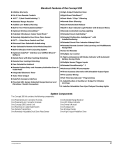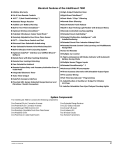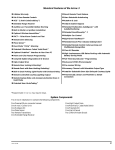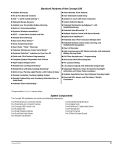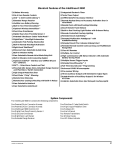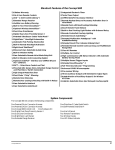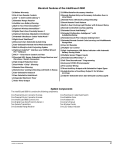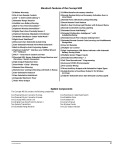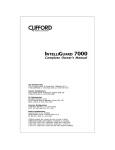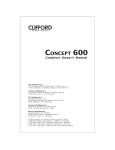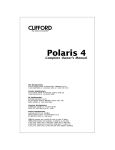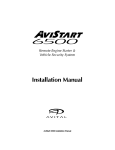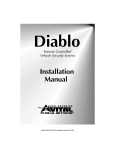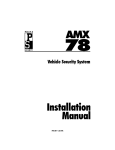Download Clifford 6000 Automobile Alarm User Manual
Transcript
Standard Features of the IntelliGuard 6000 n Lifetime Warranty n Smart Remote Trunk Release n His & Hers Remote Controls n User-Selectable AutoArming n ACG™ 2 (Anti-CodeGrabbing™) n AutoArm & Lock with Visual Indication n Extended Range Receiver n Instant AutoArm Bypass n Audible Low Transmitter Battery Warning n Patented Malfunction AutoBypass™ with AutoReMonitoring n Built-In Starter or Ignition Immobilizer n Patented SmartPowerUp™ 2 n Optional Wireless Immobilizer™ n Multiple Vehicle Control with Same Remote n FACT — False Alarm Control and Test n Eight-Event TotalRecall™ n Remote Siren Silencing n Patented Smart Prior Intrusion Attempt Alert n Dual-Zone Piezo Sensor™ n Patented Remote Control Code Learning and MultiRemote Recognition n Glass Tampering Sensor n Dual-Mode “Chirp” Silencing n Clear All Remotes n Patented UltraSecure Coded Valet Mode™ n Optional DataPort™ Interface to Your Own PC n High-Luminescence LED Status Indicator with Automatic Battery-Saving Mode n Point-and-Click Feature Programming n Full-Time SecureAccess™ Programming n Complete System Diagnostics At-A-Glance n Advanced CMOS Microcomputer n High-Output Insignia Siren n Pre-Loomed Wiring n Remote Door Locking/Unlocking* n Accessory Channel with Selectable Output Type n Remote Panic with Smart Locking/Unlocking* n Integrated Electronic Timer for Remote Headlight Activation and Timed Turbo Cooldown n Built-In Dual Parking light Flasher with Onboard Relay n Installer-Selectable Door Ajar/Delayed Courtesy Lights n Remote Controlled Courtesy Lighting Output n Remote Keyless Entry and Accessory Activation Even in Valet Mode n Prewired LED, Sensor and PlainView 2 Switch Connectors n Patented Smart AutoTesting™ Programmable (+) or (-) require relays. System Components The IntelliGuard 6000 installation kit contains the following components: One Prewired 22-pin connector harness One Prewired 4-pin connector harness One IntelliGuard 6000 Control Unit One Hardware Kit One Glass Tampering Sensor One Dual-Zone Piezo Sensor Two Remote Transmitters IntelliGuard 6000/898 Downloaded from: http://www.guardianalarms.net One Extended Range Receiver One PlainView 2 Coded Valet Switch One Insignia Siren One Prewired LED One User’s Manual Two Clifford Window Decals 1 Wiring Description for the 4-Pin Connector Pin Wire Color Connects to 1 2 3 4 Ignition Output Starter Output Ignition Input Starter Input Green/Blue White/Blue White/Brown White/Green Wiring Description for the 22-Pin Connector Pin Wire Color Connects to 1 2 3 4 5 6 7 8 9 10 11 12 13 14 15 16 17 18 19 20 21 22 Channel 4 output Prewired to the Valet Switch and Glass Tampering Sensor Piezo Sensor input - Warning Zone Valet Switch input (-) Armed output (-) Power for the Piezo and Glass Tamp. Sensors Glass Tampering Sensor input Trunk and hood trigger input (-) Piezo Sensor input - Trigger Zone Battery negative Parking light output (+) Ground for both sensors, LED connectors, and Valet Switch Door lock output (+) or (-) Door unlock output (+) or (-) Channel 2 output (-) Battery positive through 5 Amp fuse Battery positive with 20 Amp fuse Prewired to the LED connector Interior light supply (+) or (-) Door trigger input (+) or (-) Siren output (-) (black wire on Siren) Parking light output (+) 2 Gray/Blue Black Blue White Green Red Orange Gray/Yellow Orange Black Brown Black Gray/Green Gray/Orange Gray/Violet Red Red/White Violet Brown/Red Gray Yellow Brown IntelliGuard 6000/1298 Passenger Compartment Connections Control Unit and Extended Range Receiver The IntelliGuard 6000 control unit must be installed inside the vehicle. Under no circumstances should the unit be installed under the hood or other similarly hostile environment. 1. Select an area behind the dash to mount the control unit using the supplied screws, but do not permanently affix it until all wiring and testing is complete. 2. Plug the extended range receiver in to the control unit. Mount the extended range receiver away from the control unit and run the antenna either up the window pillar and affix it to the windscreen, or under the dash, away from metal. The position and location of the receiver will effect remote control range. Do not fold the excess cable or antenna wire. Do not make hard, sharp bends. Door Trigger/Interior Light Supply Please refer to the Door Trigger/Parking Lights section in this binder for information on polarity testing and connections. Central Door Locking System Please refer to the Door Locks section in this binder for information on circuit types and connections. When adding an IntelliStart 4 to the Arrow 3, it is recommended that RPM-depending door locking be selected. The RPM-dependent door locking feature is only available with the addition of the IntelliStart 4. LED Status Indicator Select a prominent location on the dash or console visible through all windows. Discuss placement with the owner. 1. Verify there is adequate space to accommodate the LED, then drill a 5/16” (8mm) hole and route the wires through it. 2. Mate the LED connectors to the VIOLET and BLACK wire connectors as shown in the diagram on page 2. 3. Press the LED into place. PlainView 2 Coded Valet Switch 1. 2. 3. 4. 5. Discuss placement of the switch with the vehicle owner and avoid placing the switch where it can be pressed accidentally. Verify there is adequate space behind the selected location to accommodate the switch. Drill a 5/16” (8mm) mounting hole, then insert the wires through the hole and mount the switch. Mate the switch’s locking connectors to the WHITE and BLACK locking connector. Remove the adhesive backing and press into place. Dual-Zone Piezo Sensor Mount the Dual-Zone Piezo Sensor in the passenger compartment, not in the engine compartment. 1. Firmly mount the sensor near the base of the steering column (if the steering column has a rotating sleeve, firmly screw the sensor to the interior firewall, kick panel or trunk wall). Make certain that the adjustment screw is accessible. 2. Mate the sensor to the connector on the wireloom from the control unit with the BLACK, RED, ORANGE and BLUE wires. Glass Tampering Sensor Mount the Glass Tampering Sensor in the passenger compartment, not the engine compartment. 1. Mount the microphone holder so that it points into the passenger compartment, but will not be exposed to direct sunlight. 2. Plug the microphone into the sensor (an optional second microphone can be added to vans and other large vehicles for increased sensitivity and better discrimination). 3. Mate the sensor to the connector on the wireloom from the control unit with the BLACK, RED and ORANGE wires. IntelliGuard 6000/1298 3 Passenger Compartment Connections (Continued) Trunk Trigger Vehicles with a ground-switching trunk light will interface directly with the IntelliGuard 6000 (on positive switching Rolls-Royce vehicles, use a relay to invert polarity). The switch may be located in or near the trunk latch or at the trunk light. If a switch cannot be located, you must add a pin switch in a location away from water channels. NOTE: If the vehicle has a dashboard trunk ajar indicator, install a 1A diode between the light and switch with the diode band pointing toward the switch. Parking Light 1. Connect the GRAY/YELLOW wire to the trunk switch. See the Door Trigger/Parking light section in this binder. Channel 2 with Selectable Output Type The channel 2 output (GRAY/VIOLET wire) can be programmed as either pulsed, latched or timed and can be programmed to operate only when the system is disarmed (e.g., for use as a remote trunk release). Channel 2 output is activated by pressing the button on the remote control. The factory setting is pulsed output (0.5 second ground). The latched output stays at ground until the button is pressed a second time, and the timed output stays at ground for any selected duration between one second and four minutes. See Installer-Programmable Features on page 9 for information on programming the output type and/or disabling operation while the system is disarmed. If the system is set to arm and disarm using two different buttons on the remote, this wire can be programmed as a negative output when unlock (disarm) is transmitted a second time. See the programming instructions on page 9. See the Timer section of this binder for information on using the system timer for Window RollUp, timed headlight activation, or as a turbo-timer for cool down. Channel 4 with Selectable Output Type and AutoActivation The channel 4 output (GRAY/BLUE wire) can be programmed as either pulsed, latched or timed. It can also be programmed to automatically activate every time the system is remotely armed. The output is activated by pressing the from the remote. Current is limited to 0.25 amp. AutoActivation is perfect when programmed as a timed-output to close the power windows and sunroof on vehicles that have an all-close feature (see the Timer section of this binder for more information on wiring this feature). See Installer-Programmable Features on page 9 for more information on programming output type and/or enabling the AutoActivation feature. Starter and Ignition Immobilization Circuits 1. Locate the ignition switch wireloom under the dash and use a voltmeter to locate the one wire that carries +12V throughout BOTH the cranking AND engine running cycles, and 0 volts when the ignition is off. 2. Start the engine, then cut the ignition wire. The engine should stop running. 3. As shown on page 2, connect the WHITE/BROWN wire to the key side of the cut ignition line. 4. Connect the GREEN/BLUE wire to the engine side of the cut ignition line. 5. Use a voltmeter to locate the one wire that carries +12V during the cranking cycle ONLY. Cut this wire, then try to start the engine. It should not crank. 6. Connect the WHITE/GREEN wire to the key side of the cut starter line. 7. Connect the WHITE/BLUE wire to the engine side of the cut starter line. NOTE: The starter circuit may carry a very high current. Be certain that the starter wire connections are solid. Engine Bay Connections High Output Insignia Siren Mount the siren in the engine compartment away from hot or moving parts and where it cannot be reached from under the vehicle, preferably opposite the exhaust system. Point the siren down to avoid water collection (see the illustration). 1. You must firmly secure the siren to the engine bay firewall or an inner wing using all three sheet metal screws supplied. 2. Using the supplied connector, connect the wireloom’s YELLOW wire to the BLACK siren wire. 3. Connect the RED wire through the 5A fuse coming from the battery positive cable clamp. 4 IntelliGuard 6000/1298 Engine Bay Connections (Continued) Hood Trigger Vehicles with a ground-switching hood light will interface directly with the IntelliGuard 6000 (on positive switching vehicles, use a relay to invert polarity). The switch may be located in or near the hood latch or at the hood light. If a switch cannot be located, you must add a pin switch in a location away from water channels. 1. Connect the GRAY/YELLOW wire to the hood switch. Final Wiring Connections 1. 2. 3. 4. Connect the RED wire to the 5A fuseholder as shown on page 2. Connect the RED/WHITE wire to the 20A fuseholder as shown on page 2. Attach the two fuseholders to the battery positive cable clamp. Attach the BLACK wires to the vehicle battery negative cable clamp. NOTE: Power and test accessories after the basic system has been tested. Individually fuse all accessory power connections. Individually fuse all +12V connections. SmartPowerUp™ 2 SmartPowerUp 2 ensures that the system powers up in the same state (disarmed, armed or valet mode) it was last in. When you first power up the system, it will silently enter its disarmed state. Delayed Courtesy Lights Some vehicles have a courtesy light delay or dimming circuit, which interferes with an alarm being able to detect the door trigger upon remote arming. If the delay or dimming lasts more than 5 seconds, no special connections or testing are needed, simply turn on the Delayed Courtesy Lights feature as noted in the Installer-Programmable Features section on page 9. Please note that since this feature sets the system to arm the instant the courtesy lights are off, the Door Ajar Warning feature will not be available. Remote Control Channel Assignments The IntelliGuard 6000 comes with two ergonomically designed remote controls: a master remote and a companion remote. Up to two additional Clifford ACG 2 remote controls can be added (older Clifford ACG and non-ACG remotes are not compatible with the IntelliGuard 6000). For instructions on how to use the remote controls, please refer to the owner’s manual. Master Remote Control Channel # Function Press button(s) 1 Arm/Disarm 2* Activate Accessory* (usually remote trunk release)* 3 Silent Arm/Disarm 4* Activate Channel 4 Accessory* (such as timed headlight activation) 5* IntelliStart 4 Accessory* ✱ 6* SmartWindows 4 Accessory* + 7* Remote Valet Mode Enter/Exit* 8* IntelliVoice 4 Accessory* 9* Unassigned* 10 Remote Piezo Sensor Override +✱ +✱ + +✱ + *These channels can be assigned to control other Clifford ACG 2 systems and accessories on the customer’s other vehicles. IntelliGuard 6000/1298 5 FACT—False Alarm Control and Test The system microprocessor automatically checks for another activated sensor or trigger before sounding the siren a second time, thus preventing any further false alarms. If you wish to test FACT, simply, 1. Arm the system with the remote control. 2. Wait 10 seconds after the interior light turns off, then trigger the Piezo Sensor to activate the siren. 3. Do not disarm the system, let the siren complete its cycle. 4. Trigger the sensor again. The alarm should be silent. 5. Unlock and open a door. The alarm should sound immediately. You may now disarm. Eight-Event TotalRecall The system’s nonvolatile memory records the identity of the last eight activated or malfunctioning triggers and sensors. NOTE: The CliffNet Wizard Pro displays the Eight-Event TotalRecall data in a graphical format. 1. 2. 3. 4. With the ignition OFF, press and hold the unmarked side of the PlainView 2 Switch. Use the remote control to arm, and then again to disarm, and then release the button. The LED will flash 1–10 times, pause, then flash 1–10 times, etc. Write down the number of flashes in each cycle. Refer to the following chart. The first number you wrote down was the most recently activated trigger or sensor. The next number is the second most recent, and so on up to as many as the last eight activations. Number of LED flashes between pauses Trigger/sensor indication 1 flash Glass Tampering Sensor 2 flashes Dual-Zone Piezo Sensor 4 flashes Door Trigger 5 flashes Trunk Trigger/Hood Trigger (trunk only, if IntelliStart 4 has been installed) 6 flashes Hood Trigger (only if optional IntelliStart 4 has been installed) 7 flashes An attempt was made to turn on the ignition or start the engine while the system was armed 8 flashes More than three consecutive incorrect valet codes were entered 10 flashes System Power Interruption 5. If a sensor is often activated, decrease that sensor’s sensitivity (or reposition the sensor, if necessary). If a certain trigger is often activated, check pin switch operation, verify that the pin switch is not exposed to moisture and check the trigger wire for possible shorting. 6 IntelliGuard 6000/1298 Certificate of Installation After installation and testing has been completed, you must fill in the Clifford Electronics Certificate of Installation. Programmable Features IntelliGuard 6000 comes from the factory with its features preprogrammed as noted in bold text in the tables on pages 8 and 9. Some features can be programmed by the installer or the user, others can only be programmed by the installer. There are two tables provided which define the user-programmable and installer-programmable features. Using the CliffNet Wizard Pro The CliffNet Wizard Pro provides intuitive access to all installer and user-programmable features through a user-friendly, graphical user interface. Because CliffNet Wizard Pro is Windows™-compatible, most operations can be accomplished by simply pointing and clicking a mouse. CliffNet Wizard Pro totally eliminates complicated programming charts and lengthy programming sequences. Please refer to the CliffNet Wizard Pro User’s Guide for more programming information if you are using the CliffNet Wizard Pro. Otherwise, for manual programming refer to the tables provided in the following sections. Programming the User-Selectable Features 1. Write down the column (across) number and row (down) number of the feature(s) you wish to program. 2. Turn the ignition to the “ON” position or start the engine. 3. Enter the factory preset valet/programming code of “2” by pressing the PlainView 2 Switch’s ✱ button twice, then press the unmarked button. 4. After entering the code, press and hold the ✱ for about 3 seconds until you hear one siren chirp and the LED turns on to acknowledge program mode entry. The IntelliGuard 6000 is now in the “Feature Select” position for User-Programmable Features. 5. Select the feature column: Press the unmarked button the same number of times as the column number. Pause. You will then hear the same number of chirps as the column number you have selected, audibly confirming your selection. 6. Within five seconds, select the feature row: Press the ✱ button the same number of times as the feature’s row number. You’ll hear a chirp each time you press the button to help you count. 7. If there is a NOTE for the selected feature, perform the actions noted. 8. Pause. You will hear either one or two chirps: two chirps = ON, one chirp = OFF. 9. You can select another feature, or you can exit program mode: a. To select another feature in that same column, repeat step 6 within the next five seconds (after five seconds, three chirps indicate that the IntelliGuard 6000 is now back in the “Feature Select” position). b. To select a different feature column, repeat step 5. c. To exit program mode, turn the ignition off (you’ll hear three chirps and the LED will turn off to indicate exit of program mode), or wait 60 seconds and the IntelliGuard 6000 will automatically exit program mode. It may sound a little complicated, but it really isn’t. Briefly, here is all you do: choose the feature you want to change, enter program mode, select that feature’s column and row, wait for the on/off chirp confirmation, then turn off the ignition. That’s it! IntelliGuard 6000/1298 7 User-Programmable Features User-Programmable Features (1 Chirp = OFF, 2 Chirps = ON) Feature Select Unmarked 1 Unmarked 2 Unmarked 3 Unmarked 4 ✱1 Add New Remote NOTE 1 Chirps (Off/On/Quiet*) (1 chirp/2 chirps/3 chirps) *Quiet chirps are only available with SSPS Siren AutoArming (On/Off) Arm/Disarm with Secondary Remote NOTE 5 ✱2 Siren Sounds (Requires SSPS Siren) NOTE 2 NOT USED AutoArm & Lock (On/Off) Trunk Release with Secondary Remote NOTE 6 ✱3 Play Siren Sounds (Requires SSPS SIren) Remote Valet Feature (On/Off) NOT USED Silent Arm/Disarm with Secondary Remote NOTE 6 ✱4 Siren Duration (30/60/90 Seconds) (1 Chirp/2 Chirps/3 Chirps) AutoStart Neither/Battery/Temperature/Both) (1 chirp/2 chirps/3 chirps/4 chirps) (Requires IntelliStart 4) FACT (Off/On) NOT USED ✱5 AutoLock (Off/On/RPM*) (1 Chirp/2 Chirps/3 Chrrps) (IntelliStart 4 required for RPM dependent door locking) NOT USED Remote Start with Secondary Remote (Requires IntelliStart 4) NOTE 6 NOT USED ✱6 AutoUnlock (On/Off) Clear All Remotes NOTE 4 NOT USED Window Rolldown/Venting with Secondary Remote (Requires SmartWindows 4) NOTE 6 ✱7 Reset All to Factory Settings (except remote controls and valet code) NOTE 3 Valet Code SHOULD ONLY BE PROGRAMMED BY THE VEHICLE OWNER NOT USED Remote Valet Mode with Secondary Remote NOTE 6 n NOTE 1: Press the button on the remote to be programmed, you will hear one chirp. Press the button again, you will hear two chirps. n NOTE 2: When this feature is selected, siren sound 1 will play for five seconds. Press marked to turn the siren sound off, press unmarked to activate the sound. Next, siren sound 2 will play for five seconds. Press marked to turn the siren sound off, unmarked to activate it. The system will cycle through all six siren sounds. n NOTE 3: You will hear two chirps when all features are reset. n NOTE 4: When you hear two chirps, all remote controls will have been erased from the system memory. You must now add the new and/or existing remote controls to the system (i.e., AutoProgram each remote that will be used with the IntelliGuard 6000). n NOTE 5: Programs a remote control from any other Clifford system (that uses ACG 2 technology) to arm or disarm the vehicle. For instance, to set the button + ✱ combination of the other car’s master remote control to arm/disarm the system, select column 4, row 1, then transmit the + ✱ button combination from the remote you are programming. The system will respond with one chirp. Immediately press the button combination a second time. The system will respond with two chirps. The other vehicle’s remote will now arm/disarm the system by pressing the and ✱ buttons simultaneously. n NOTE 6: This feature can be controlled by a secondary remote or any remote control of any other ACG 2 system, after that remote has been programmed to arm/disarm this system. Select the row and column number, then transmit the unused button on the other remote that you want to use to perform that function. The system will respond with the same number of chirps as the row number. Please note that you must first set a button on the remote that will arm/disarm the system (column 4, row 1) before these others will be accepted. 8 IntelliGuard 6000/1298 Installer-Programmable Features To access the installer-programmable features, use the procedure defined in the User-Programmable section, but after completing step 4, continue to press and hold the ✱ side of the PlainView 2 Switch for another 10 seconds. You will hear three confirmation chirps indicating that the system is in installer-program mode. Table of Installer-Programmable Features: 1 chirp = OFF, 2 chirps = ON. Feature Select Unmarked 1 Unmarked 2 Unmarked 3 ✱1 Single/Double Lock Pulse (1 chirp/2 chirps) Channel 2 Timer Duration (10 Seconds) NOTE 1 Door Ajar Warning/Delayed Courtesy Lights (1 chirp/2 chirps) ✱2 Single/Double Unlock Pulse (1 chirp/2 chirps) Auxiliary Channel 2 type (Pulsed/Timed/Latched) (1 chirp/2 chirps/3 chirps) Auxiliary Channel 2 Interlock (On/Off) ✱3 Lock/Unlock Pulse 1 second/3 second (1 chirp/2 chirps) Arm/Disarm on Single Button (Off/On) NOTE 2 Auxilliary Channel 2 output Activate as door unlock NOTE 3 ✱4 Door Lock Polarity Positive/Negative (1 chirp/2 chirps) Diesel Engine/Petrol Engine AutoActivate Auxiliary Channel 2 (1 chirp/2 chirps) (On/Off) (Requires Optional IntelliStart 4) ✱5 Program RPM (Requires Optional IntelliStart 4) Program Optional SmartWindows 4 Program Door Polarity (Positive/Negative) (1 chirp/2 chirps) NOTE 1: Once this feature is selected, you will hear one chirp to confirm that the timer has started. You can set this anywhere from one to 4.25 minutes (255 seconds). When the desired duration has been reached, press the unmarked side of the PlainView 2 switch. You will hear two chirps to confirm the new system timer duration. NOTE 2: Must have a four button remote to use this feature. If this feature is disabled (the default setting), then arm and disarm will be on a single button. NOTE 3: Arm/Disarm on single button must be set to OFF to use this feature, auxilliary channel 2 output type must be set to pulsed. System Checklist & Troubleshooting The following checklist and troubleshooting tips will assure that you have installed the IntelliGuard 6000 correctly. If the system does not react as noted, follow the troubleshooting tip(s) denoted with a black box below that item, then repeat the step. Each successive step requires that the previous step has been completed as indicated. Step 1. Re-enable the courtesy lights. In step 1 of the Important Information section (the first tabbed section) in this binder, the interior courtesy lights were disabled. You must now re-enable the courtesy lights by replacing the fuse you removed or reset the courtesy light switch back to its normal “DOOR” position before proceeding. Step 2. Test the Immobilization circuit. n Turn the ignition to the “ON” position and start the engine. Let the engine run for at least 10 seconds, then turn the ignition “OFF.” After 30 seconds have passed, the AutoImmobilisation circuit will engage (indicated by a slow flash of the LED). Turn the ignition to the “ON” position. The engine should not respond (it should neither start nor crank). o Engine does not respond. This is the correct response, proceed to the next AutoImmobilisation test. o Engine starts or cranks. Check the power and ground connections, then check to see if starter/ignition/fuel pump or immobilisation circuit has been miswired. Carefully retest the vehicle wires as noted in the Starter and Ignition Immobilization Circuit section on page 4. IntelliGuard 6000/1298 9 System Checklist & Troubleshooting (Continued) n Arm the IntelliGuard 6000 (either from inside or outside the vehicle) and wait 10 seconds. Turn the ignition to the “ON” position. o Engine does not respond and alarm triggers. This is the correct response, proceed to step 3. o Engine starts or cranks. The starter immobilisation circuit has been miswired. Carefully retest the vehicle wires as noted in the Starter or Ignition AutoImmobilization Circuit section on page 4. o Engine still starts or cranks after retesting all the wiring as noted on page 4, check the power and ground connections. Then make sure the fuses are in the fuseholders, verify the control unit connectors are securely fastened, verify the ignition wires are connected to the true ignition line instead of a 12V or accessory line, and verify that the transmitters are programmed correctly. Step 3. Test the chirps. Close all doors and arm the IntelliGuard 6000 by pressing the button on the remote control. n 2 Chirps: This is the correct response. Proceed to step 4. n 1 Chirp: If you hear only one chirp, the IntelliGuard 6000 had previously armed itself passively and by pressing the button, the system disarmed (remote disarming is acknowledged with one chirp and one parking light flash). Disarm and rearm the system. n 4 Chirps: If you hear 4 chirps either immediately or 5-10 seconds after the initial two chirps, a trigger or sensor is open or active, or the vehicle has delayed courtesy lights and the Delayed Courtesy Lights feature has not been programmed on. Disarm with the remote control, enter the vehicle and turn on the ignition. The LED will flash 1–10 times, pause, then repeat the same number of flashes (the flash cycle repeats five times for your convenience). Refer to the following chart. Number of LED flashes between pauses Trigger/sensor indication 1 flash Glass Tampering Sensor 2 flashes Dual- Level Piezo Sensor 4 flashes* Door Trigger* 5 flashes Trunk Trigger (trunk only, if IntelliStart 4 has been installed) 6 flashes Hood Trigger (only if IntelliStart 4 has been installed) 7 flashes An attempt was made to turn the ignition “ON” or start the engine while the system was armed 10 flashes Power Interruption * If the delayed courtesy lights feature is activated, this trigger indication will not be provided. o If the door trigger is indicated, activate the delayed courtesy lights feature. No chirps. If there are no chirps, verify that the Chirps feature (User-Programming - column 2, row 1) is “On” and check the n wiring connections as noted in the High Output Siren section on page 4. NOTE: If none of the troubleshooting techniques described in steps 3 - 7 corrects the problem, perform the following diagnostics: o Make sure the fuses are in the fuseholders. o Check the power and ground connections. o Verify that the control unit connector is properly inserted into the control unit. o Verify that the ignition input and output wires are connected to the true ignition line instead of a 12V line. Find the true ignition line by following the appropriate steps of the Starter or Ignition AutoImmobilisation Circuit section on page 4. o Verify that the transmitters are programmed correctly. NOTE: If the 20A fuse blows upon arming: o Disconnect the IntelliGuard 6000’s two parking light wires, replace the 20A fuse and rearm. If the fuse blows while the parking light wires are disconnected, the door locks are not wired correctly. Reconnect the vehicle’s power locking system to its original condition, then retest the voltages as indicated in the Central Door Locking/Unlocking section of this binder and wire the locks as indicated, then replace the 20A fuse. 10 IntelliGuard 6000/1298 System Checklist & Troubleshooting (Continued) Step 4. Test the parking lights. Arm the system. n Two flashes. This is the correct response, proceed to step 5. n One flash. If the parking lights flash only once, the IntelliGuard 6000 had previously AutoArmed itself passively and by pressing the arm/disarm button the system disarmed (remote disarming is acknowledged with one chirp and one parking light flash). Disarm and rearm the system. n No flashes. If no flashes, verify the parking light bulbs are operational. If not, they must be replaced. If so, repeat steps 1-5 of the Parking lights section in this binder. n Only one side flashes. If only the right or the left side parking lights flash, see the Parking lights section in this binder. Step 5. Test the door locks. Arm the system. n Doors lock. This is the correct response, proceed to step 6. n Doors do not lock. You either selected the wrong door lock diagram , connected the wires incorrectly, or a servo may be required. Reconnect the vehicle’s power locking system to its original condition, then retest the voltages as indicated in the Door Locking/Unlocking section of this binder and wire the locks as indicated. Polarity programming should also be verified. WARNING: If the doors do not lock, DO NOT activate the vehicle’s lock switches. If the locks have been miswired, doing so may damage the IntelliGuard 6000 control unit, the vehicle’s electrical system and/or the power lock servo motors. n Doors unlock. You either selected the wrong door lock diagram, connected the wires incorrectly, or a servo may be required. Reconnect the vehicle’s power locking system to its original condition, then retest the voltages as indicated in the Door Locking/Unlocking section of this binder and wire the locks as indicated. n Only one door locks. You either selected the wrong door lock diagram, connected the wires incorrectly, or a servo may be required. Reconnect the vehicle’s power locking system to its original condition, then retest the voltages as indicated in the Door Locking/Unlocking section of this binder and wire the locks as indicated. Step 6. Test the LED. Arm the system. n Flashes repeatedly. This is the correct response, proceed to step 7. n No flashes. If the LED does not flash, verify that the LED’s VIOLET and BLACK wires are solidly connected to the same color wires on the IntelliGuard 6000’s wireloom. Warning: This is a 2-volt LED, testing with 12 volts will destroy the LED. Step 7. Test the Valet Switch. n Test the valet code and switch operation. Use the instructions provided on page 7 to enter programming mode. If the system enters programming mode, the switch and valet code are in operating order. If not, perform the following tests: n Test the WHITE wire at the control unit connector. It should rest at 5 volts. When pressing the marked side, it should read 3 volts and when pressing the unmarked side it should read 0 volts. If any reading is incorrect, move the voltmeter to the BLACK wire at the valet switch. It should read 0 volts at rest, 0 volts when the marked side marked is pressed, and 0 volts when the unmarked side is pressed. If the BLACK wire tests correctly and the WHITE wire does not, replace the switch. If the BLACK wire tests incorrectly, repair the ground circuit. If both wires test correctly, then the valet code has been changed. Use the CliffNet Wizard Pro to reset the valet code. IntelliGuard 6000/1298 11 System Checklist & Troubleshooting (Continued) Step 8. Test the disarm function. n Disarm the system. The following should occur: o Siren chirps once. If the siren does not chirp once, refer to step 3. o Parking lights flash once. If the parking lights do not flash once, refer to step 4. o LED stops flashing. If not refer to step 6. o Doors unlock. If not refer to step 5. o Immobilizer circuits immediately disengage (test this by turning the key in the ignition switch; the engine should crank, start and idle normally). If the Immobilizer circuits do not disengage, refer to step 2. o Interior courtesy light(s) turn on and stay on for 30 seconds or until the ignition is turned on, whichever occurs first. o If the interior light(s) do not turn on, verify that you replaced the interior light fuse you removed or have turned the lights back on as noted in step 1 of this section. o Check the IntelliGuard 6000’s 10A fuse. If the fuse blew when you disarmed, the vehicle uses a positive door trigger and you connected the interior light supply wire to ground instead of +12 volts. Replace the 10A fuse and retest. o Check the door trigger circuit. See step 8 for more information on testing the door trigger circuit. Step 9. Test the door trigger circuit. Rearm the system. Wait at least 10 seconds (if the vehicle has delayed or dimming courtesy lights, be sure to wait at least 10 seconds after the interior lights have turned off). Use the key to unlock and open the driver’s door. n Siren sounds, parking lights flash repeatedly. This is the correct response, proceed to step 9. (You can silence the siren by pressing the button on the remote control once or disarm by pressing the button twice.) n Siren does not sound immediately. If the alarm does not sound immediately when one of the doors is opened, make sure that that door’s pin switch is working properly and, when open, is consistently showing less than 1.5 volts if the vehicle has negative-switching door triggers or more than +11 volts if the vehicle has positive-switching door triggers, also make sure the pin switch is connected to the correct wire. If not, then the door pin switch (or pin switches) is either defective or in need of cleaning. Step 10. Test the trunk trigger circuit. Arm the system, then use the key to unlock the trunk. n Siren sounds immediately, parking lights flash repeatedly. This is the correct response, proceed to step 10. (You can silence the siren by pressing the button on the remote control or disarm by pressing the twice.) n Alarm does not sound immediately. If the alarm does not sound immediately, make sure that the trunk pin switch is working properly and, when open, is consistently showing less than 1.5 volts. Also make sure the trunk pin switch is connected to the correct wire. If not, the trunk pin switch must be thoroughly cleaned or replaced, or polarity may need to be inverted. Step 11. Test the hood trigger circuit. Arm the system, then open the hood. The following should occur: n Siren sounds immediately, parking lights flash repeatedly. This is the correct response, proceed to step 11. (You can silence the siren by pressing the button on the remote control or disarm by pressing the button twice.) n Alarm does not sound immediately. If the alarm does not sound immediately, make sure that the hood pin switch is working properly and, when open, is consistently showing less than 1.5 volts. If not, the hood pin switch must be thoroughly cleaned or replaced, or polarity may need to be inverted. Step 12. Test the AutoArming feature. Turn the ignition “ON” and let the car idle for 10 seconds. Turn the ignition “OFF,” then open and close the door. Wait five seconds. n Parking lights flash twice. 25 seconds later, the vehicle arms passively as indicated by a rapidly flashing LED. This is the correct response, proceed to step 12. n System does not passively arm. o Make sure that Instant AutoArming has been turned on using the programming instructions on page 8. o Verify the door trigger connection (see step 8). 12 IntelliGuard 6000/1298 System Checklist & Troubleshooting (Continued) Step 13. Test the AutoArming Bypass feature. Disarm the system. Turn the ignition to the “ON” position, then turn the ignition “OFF.” n One Chirp. This is the correct response, wait 30 seconds after the interior lights have turned off to insure the system does not passively arm. Proceed to step 13. Step 14. Test remote control range. Stand approximately 50 feet from the vehicle and use the remote control to arm and disarm the system. n The IntelliGuard 6000 will respond with the previously noted indications for arming and disarming. If not: o Reposition the external receiver as high up as possible under the dash or on the windscreen and as far as possible from heavy wirelooms and metal. Rotate the external receiver 90 degrees and re-test. o Make sure that the remote control battery measures at least 3 volts while transmitting. o Make sure that the voltage at the control unit between the 5A fused power line and each of the two ground lines measures at least 12.0 volts (if less, make sure both chassis grounds are solid; if the grounds are solid, the vehicle battery may need charging, servicing or replacement). Step 15. Distribute all necessary paperwork including: n User’s Manual must be given to the customer. n Adhere the Clifford window decals to the vehicle’s windows after discussing placement with the vehicle owner. Step 16. Demonstrate Basic System Operation: n Remote control operation: o Arming and locking o Disarming and unlocking o Remore Valet Mode o Panic button o Accessory Activation n AutoArming and AutoArming Bypass n Valet code entry n User-programming mode IntelliGuard 6000/1298 13













